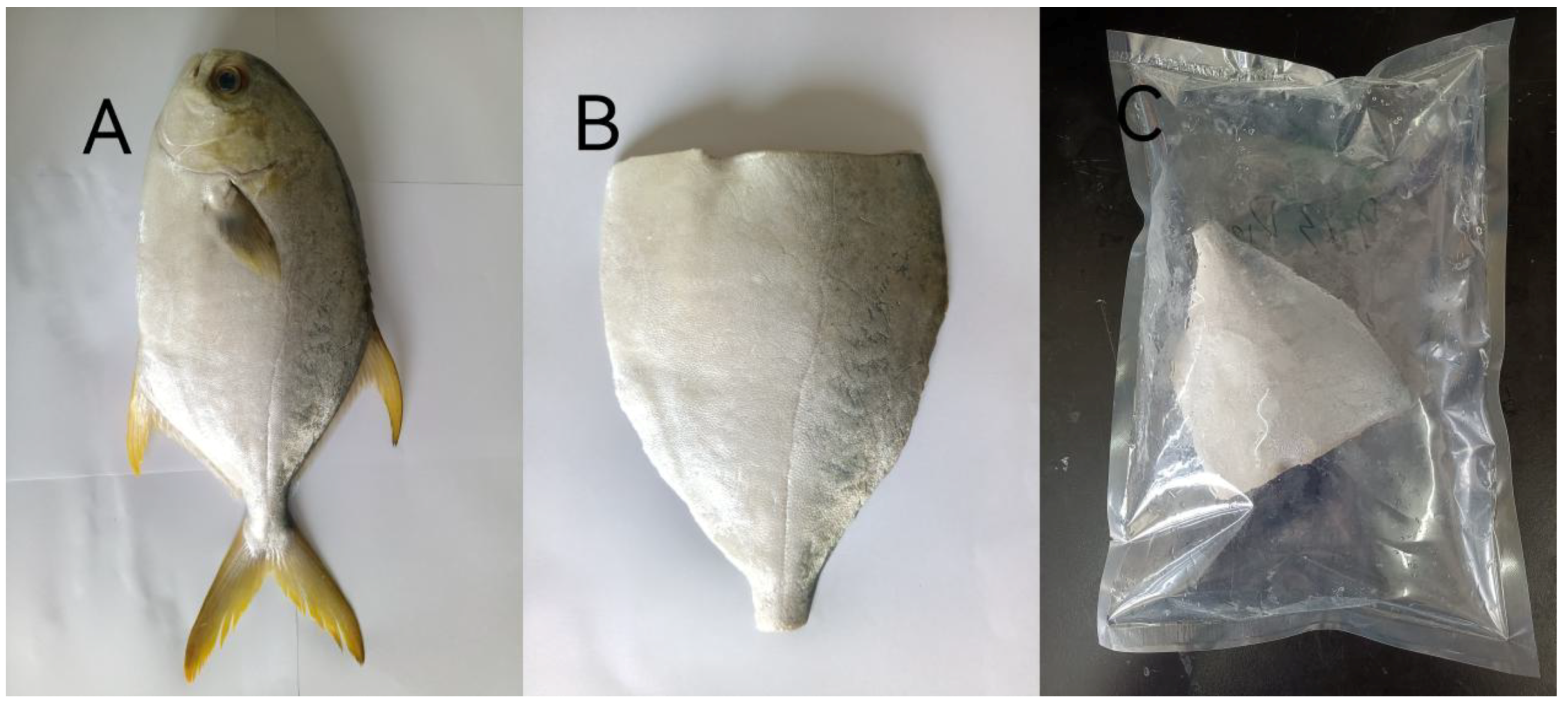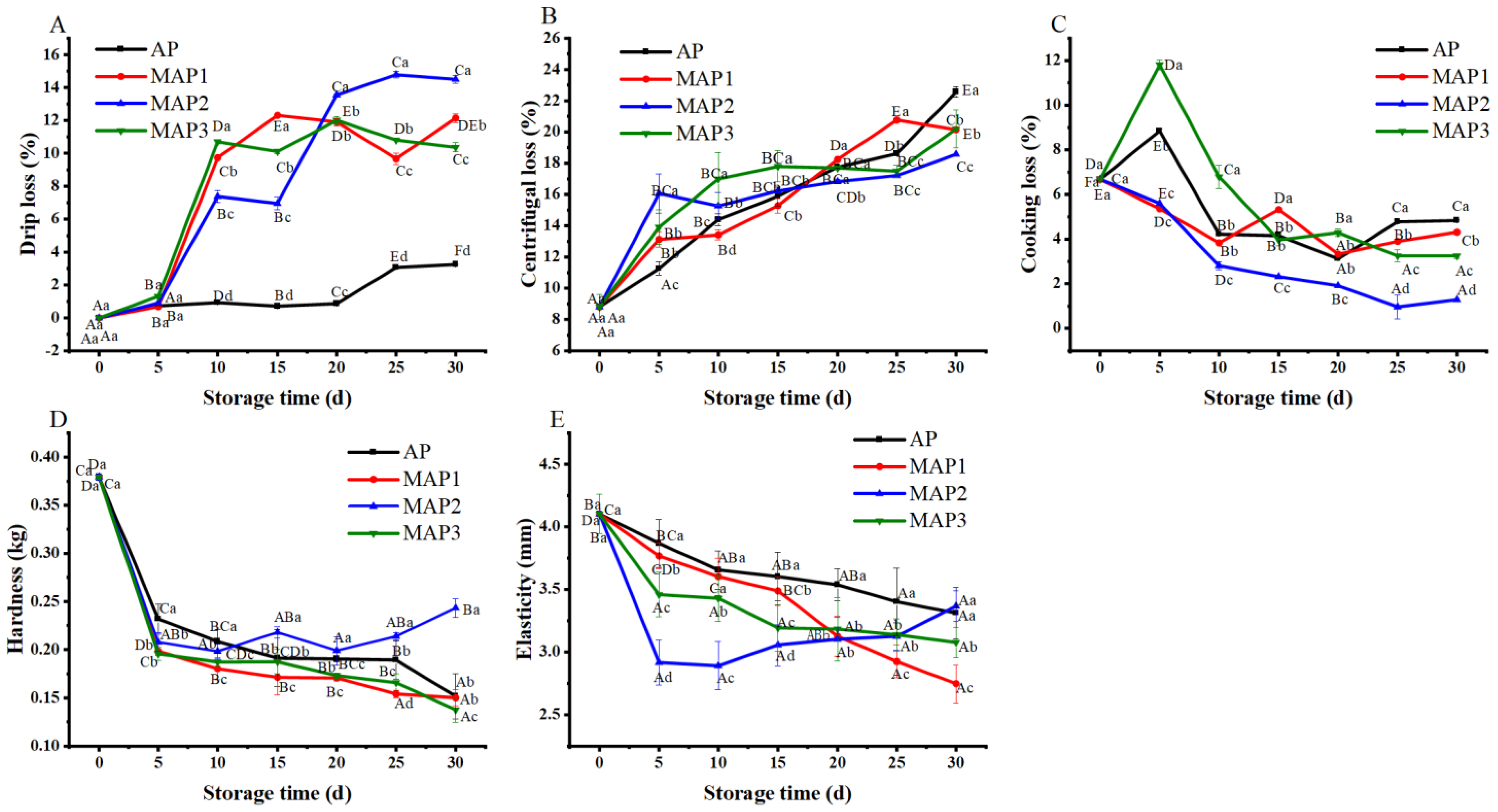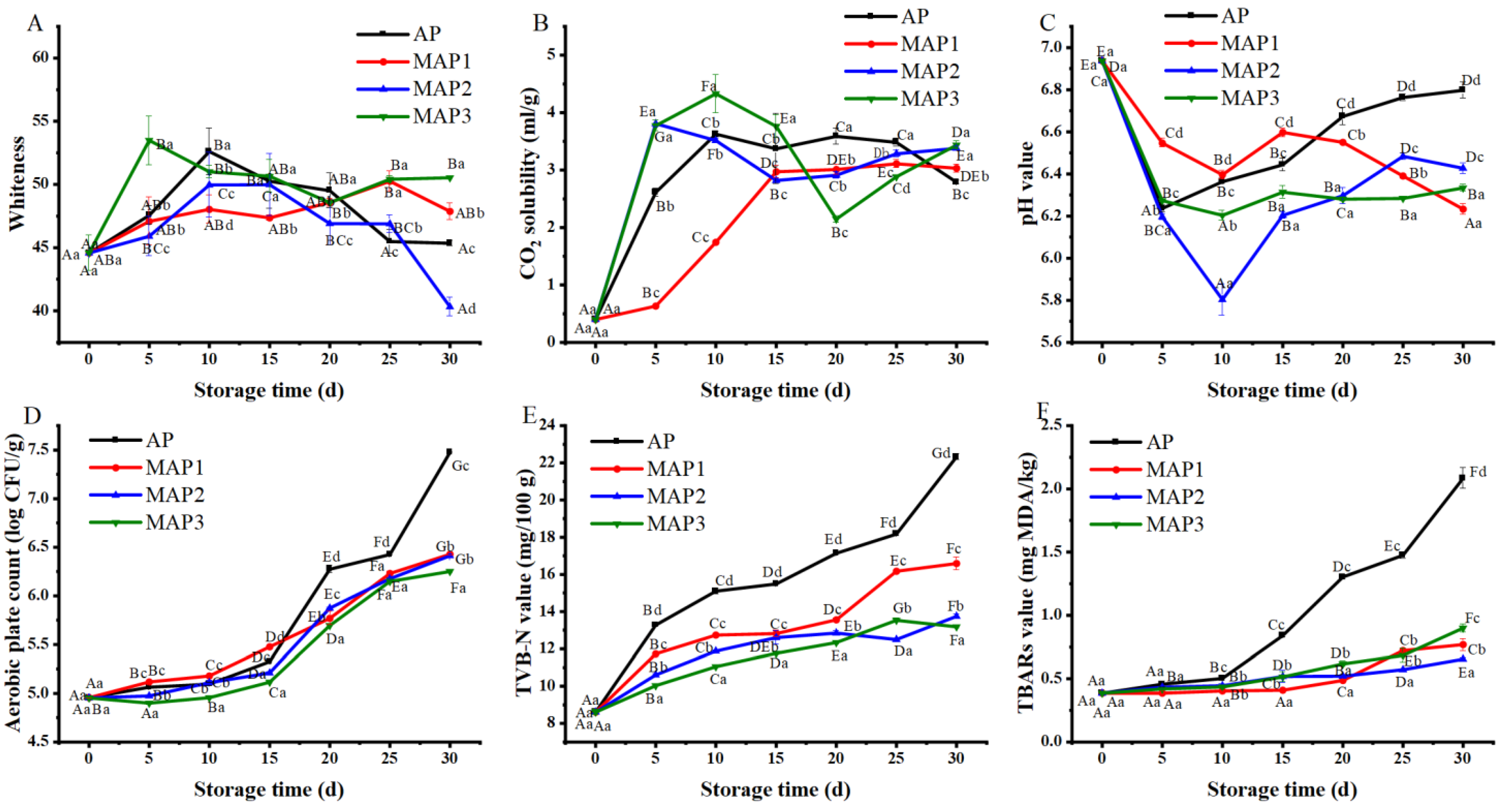Effects of Modified Atmosphere Packaging with Different Gas Ratios on the Quality Changes of Golden Pompano (Trachinotus ovatus) Fillets during Superchilling Storage
Abstract
:1. Introduction
2. Materials and Methods
2.1. Sample Preparation
2.2. Water Retention Analysis of Golden Pompano Fillets
2.2.1. Determination of Drip Loss
2.2.2. Determination of Cooking Loss
2.2.3. Determination of Centrifugal Loss
2.3. Physical Analysis of Golden Pompano Fillets
2.3.1. Texture Profile Analysis
2.3.2. Determination of pH and Whiteness
2.3.3. Determination of Solubility of CO2
2.4. Microbiological and Chemical Analysis of Golden Pompano Fillets
2.4.1. Determination of the Aerobic Plate Count (APC)
2.4.2. Determination of Total Volatile Basic Nitrogen (TVB-N) Value
2.4.3. Determination of Thiobarbituric Acid-Reactive Substances (TBARs)
2.5. Statistical Analysis
3. Results and Discussion
3.1. Effect of Different Gas Ratios on Water Retention of Golden Pompano Fillets
3.2. Effect of Different Gas Ratios on Physicochemical Changes of Golden Pompano Fillets
3.2.1. Changes in Texture
3.2.2. Changes in Whiteness
3.2.3. Changes in CO2 Solubility
3.2.4. Changes in pH Value
3.2.5. Changes in TVB-N Value
3.2.6. Changes in TBARs Value
3.3. Effect of Different Gas Ratios on APC of Golden Pompano Fillets
3.4. Principal Component Analysis of Quality Indicators of Golden Pompano Fillets
3.4.1. Pearson Correlation Analysis of Quality Indicators
3.4.2. Principal Component Analysis of Quality Indicators
4. Conclusions
Author Contributions
Funding
Institutional Review Board Statement
Informed Consent Statement
Data Availability Statement
Acknowledgments
Conflicts of Interest
References
- Li, P.; Zhou, L.; Ni, S.; Xu, M.; Yu, Y.; Cai, J.; Wei, S.; Qin, Q. Establishment and characterization of a novel cell line from the brain of golden pompano (Trachinotus ovatus). In Vitro Cell. Dev. Biol. Anim. 2016, 52, 410–418. [Google Scholar] [CrossRef]
- Qiu, X.; Chen, S.; Liu, G.; Lin, H. Characterization of Farmed Ovate Pompano (Trachinotus ovatus Linnaeus) Freshness during Ice Storage by Monitoring the Changes of Volatile Profile. FSTR 2014, 20, 79–84. [Google Scholar] [CrossRef] [Green Version]
- Magnussen, O.M.; Haugland, A.; Torstveit Hemmingsen, A.K.; Johansen, S.; Nordtvedt, T.S. Advances in superchilling of food—Process characteristics and product quality. Trends Food Sci. Technol. 2008, 19, 418–424. [Google Scholar] [CrossRef]
- Mi, H.; Qian, C.; Zhao, Y.; Liu, C.; Mao, L. Comparison of Superchilling and Freezing on the Microstructure, Muscle Quality and Protein Denaturation of Grass Carp (Ctenopharyngodon idellus): Superchilling and Freezing of Grass Carp. J. Food Process. Preserv. 2013, 37, 546–554. [Google Scholar] [CrossRef]
- Banerjee, R.; Maheswarappa, N. Superchilling of muscle foods: Potential alternative for chilling and freezing. Crit. Rev. Food Sci. Nutr. 2017, 59, 1256–1263. [Google Scholar] [CrossRef]
- Liu, Q.; Kong, B.; Han, J.; Chen, Q.; He, X. Effects of superchilling and cryoprotectants on the quality of common carp (Cyprinus carpio) surimi: Microbial growth, oxidation, and physiochemical properties. LWT Food Sci. Technol. 2014, 57, 165–171. [Google Scholar] [CrossRef]
- Liu, D.; Liang, L.; Xia, W.; Regenstein, J.M.; Zhou, P. Biochemical and physical changes of grass carp (Ctenopharyngodon idella) fillets stored at −3 and 0 °C. Food Chem. 2013, 140, 105–114. [Google Scholar] [CrossRef]
- Allende, A.; Oñez, A.; Bolton, D.; Chemaly, M.; Davies, R.; Cesare, A.; Bover-Cid, S. The use of the so-called ‘superchilling’ technique for the transport of filletsery products. EFSA J. 2021, 19, 6378. [Google Scholar] [CrossRef]
- Wu, C.; Yuan, C.; Ye, X.; Hu, Y.; Chen, S.; Liu, D. A Critical Review on Superchilling Preservation Technology in Aquatic Product. J. Integr. Agric. 2014, 13, 2788–2806. [Google Scholar] [CrossRef] [Green Version]
- Garrido, M.D.; Hernández, M.D.; Espinosa, M.C.; López, M.B. Enhanced Quality Characteristics of Refrigerated Seabream (Sparus aurata) Fillets Packed Under Different Systems (Modified Atmosphere vs. Vacuum). J. Aquat. Food Prod. Technol. 2016, 25, 156–168. [Google Scholar] [CrossRef]
- Qiu, L.; Zhang, M.; Tang, J.; Adhikari, B.; Cao, P. Innovative technologies for producing and preserving intermediate moisture foods: A review. Food Res. Int. 2019, 116, 90–102. [Google Scholar] [CrossRef]
- Bassey, A.P.; Chen, Y.; Zhu, Z.; Odeyemi, O.A.; Gao, T.; Olusola, O.O.; Ye, K.; Li, C.; Zhou, G. Evaluation of spoilage indexes and bacterial community dynamics of modified atmosphere packaged super-chilled pork loins. Food Control 2021, 130, 108383. [Google Scholar] [CrossRef]
- Yin, C.; Wang, J.; Qian, J.; Xiong, K.; Zhang, M. Quality changes of rainbow trout stored under different packaging conditions and mathematical modeling for predicting the shelf life. Food Packag. Shelf Life 2022, 32, 100824. [Google Scholar] [CrossRef]
- Mei, J.; Liu, F.; Fang, S.; Lan, W.; Xie, J. High-CO2 Modified Atmosphere Packaging with Superchilling (−1.3 °C) Inhibit Biochemical and Flavor Changes in Turbot (Scophthalmus maximus) during Storage. Molecules 2020, 25, 2826. [Google Scholar] [CrossRef]
- Sivertsvik, M.; Rosnes, J.T.; Kleiberg, G.H. Effect of Modified Atmosphere Packaging and Superchilled Storage on the Microbial and Sensory Quality of Atlantic Salmon (Salmo salar) Fillets. J. Food Sci. 2003, 68, 1467–1472. [Google Scholar] [CrossRef]
- Zhu, Y.; Ma, L.; Yang, H.; Xiao, Y.; Xiong, Y.L. Super-chilling (−0.7 °C) with high-CO2 packaging inhibits biochemical changes of microbial origin in catfish (Clarias gariepinus) muscle during storage. Food Chem. 2016, 206, 182–190. [Google Scholar] [CrossRef]
- China Fishery Statistical Yearbook; China Statistics Press: Beijing, China, 2021; pp. 87–98.
- Delles, R.M.; Xiong, Y.L. The effect of protein oxidation on hydration and water-binding in pork packaged in an oxygen-enriched atmosphere. Meat Sci. 2014, 97, 181–188. [Google Scholar] [CrossRef]
- Pathare, P.B.; Opara, U.L.; Al-Said, F.A.-J. Colour Measurement and Analysis in Fresh and Processed Foods: A Review. Food Bioprocess Technol. 2013, 6, 36–60. [Google Scholar] [CrossRef]
- Jakobsen, M.; Bertelsen, G. Predicting the amount of carbon dioxide absorbed in meat. Meat Sci. 2004, 68, 603–610. [Google Scholar] [CrossRef]
- Cheng, J.-H.; Sun, D.-W.; Pu, H.-B.; Wang, Q.-J.; Chen, Y.-N. Suitability of hyperspectral imaging for rapid evaluation of thiobarbituric acid (TBA) value in grass carp (Ctenopharyngodon idella) fillet. Food Chem. 2015, 171, 258–265. [Google Scholar] [CrossRef]
- Kimbuathong, N.; Leelaphiwat, P.; Harnkarnsujarit, N. Inhibition of melanosis and microbial growth in Pacific white shrimp (Litopenaeus vannamei) using high CO2 modified atmosphere packaging. Food Chem. 2020, 312, 126114. [Google Scholar] [CrossRef] [PubMed]
- Zhang, M.; Meng, X.; Bhandari, B.; Fang, Z. Recent Developments in Film and Gas Research in Modified Atmosphere Packaging of Fresh Foods. Crit. Rev. Food Sci. Nutr. 2016, 56, 2174–2182. [Google Scholar] [CrossRef] [PubMed]
- Mastromatteo, M.; Danza, A.; Conte, A.; Muratore, G.; Del Nobile, M.A. Shelf life of ready to use peeled shrimps as affected by thymol essential oil and modified atmosphere packaging. Int. J. Food Microbiol. 2010, 144, 250–256. [Google Scholar] [CrossRef] [PubMed]
- Qian, Y.-F.; Xie, J.; Yang, S.-P.; Wu, W.-H.; Xiong, Q.; Gao, Z.-L.; Shi, J.-B. Effect of CO2 on Chemical and Microbial Changes of Pacific White Shrimp during Modified Atmosphere Packaging. J. Aquat. Food Prod. Technol. 2016, 25, 644–655. [Google Scholar] [CrossRef]
- Thepnuan, R.; Benjakul, S.; Visessanguan, W. Effect of Pyrophosphate and 4-Hexylresorcinol Pretreatment on Quality of Refrigerated White Shrimp (Litopenaeus vannamei) Kept under Modified Atmosphere Packaging. J. Food Sci. 2008, 73, S124–S133. [Google Scholar] [CrossRef]
- Yang, Z.; Liu, S.; Sun, Q.; Zheng, O.; Wei, S.; Xia, Q.; Ji, H.; Deng, C.; Hao, J.; Xu, J. Insight into muscle quality of golden pompano (Trachinotus ovatus) frozen with liquid nitrogen at different temperatures. Food Chem. 2022, 374, 131737. [Google Scholar] [CrossRef]
- Erdağ, M.; Ayvaz, Z. The Use of Color to Determine Fish Freshness: European Seabass (Dicentrarchus labrax). J. Aquat. Food Prod. Technol. 2021, 30, 847–867. [Google Scholar] [CrossRef]
- Messina, C.M.; Bono, G.; Renda, G.; La Barbera, L.; Santulli, A. Effect of natural antioxidants and modified atmosphere packaging in preventing lipid oxidation and increasing the shelf-life of common dolphinfish (Coryphaena hippurus) fillets. LWT Food Sci. Technol. 2015, 62, 271–277. [Google Scholar] [CrossRef]
- Fu, L.; Zhang, S.; Zhou, J.; Liu, C.; Lin, J.; Wang, Y. Alterations of Protein Expression in the Muscle of Pacific White Shrimp (Litopenaeus vannamei) Contribute to Postmortem Changes. J. Shellfish Res. 2014, 33, 815–823. [Google Scholar] [CrossRef]
- Genç, İ.Y.; Esteves, E.; Aníbal, J.; Diler, A. Effects of chilled storage on quality of vacuum packaged meagre fillets. J. Food Eng. 2013, 115, 486–494. [Google Scholar] [CrossRef]
- Lan, W.Q.; Xie, J.; Zhu, F.; Zhu, R.Q. The Effects of Quality Changes in Pomfret (Pampus argenteus) Fillets from Different Treatments during Chilled Storage. AMR 2014, 1051, 378–382. [Google Scholar] [CrossRef]
- Arashisar, Ş.; Hisar, O.; Kaya, M.; Yanik, T. Effects of modified atmosphere and vacuum packaging on microbiological and chemical properties of rainbow trout (Oncorynchus mykiss) fillets. Int. J. Food Microbiol. 2004, 97, 209–214. [Google Scholar] [CrossRef] [PubMed]
- Zakrys, P.I.; Hogan, S.A.; O’Sullivan, M.G.; Allen, P.; Kerry, J.P. Effects of oxygen concentration on the sensory evaluation and quality indicators of beef muscle packed under modified atmosphere. Meat Sci. 2008, 79, 648–655. [Google Scholar] [CrossRef] [PubMed]
- Daskalov, H. The importance of Aeromonas hydrophila in food safety. Food Control 2006, 17, 474–483. [Google Scholar] [CrossRef]
- Fernández-Saiz, P.; Sánchez, G.; Soler, C.; Lagaron, J.M.; Ocio, M.J. Chitosan films for the microbiological preservation of refrigerated sole and hake fillets. Food Control 2013, 34, 61–68. [Google Scholar] [CrossRef]
- Esteves, E.; Guerra, L.; Anibal, J. Effects of Vacuum and Modified Atmosphere Packaging on the Quality and Shelf-Life of Gray Triggerfish (Balistes capriscus) Fillets. Foods 2021, 10, 250. [Google Scholar] [CrossRef]
- López-Caballero, M.; Gonçalves, A.; Nunes, M. Effect of CO2/O2-containing modified atmospheres on packed deepwater pink shrimp (Parapenaeus longirostris). Eur. Food Res. Technol. 2002, 214, 192–197. [Google Scholar] [CrossRef]
- Singh, R.; Giri, S.K.; Kotwaliwale, N. Shelf-life enhancement of green bell pepper (Capsicum annuum L.) under active modified atmosphere storage. Food Packag. Shelf Life 2014, 1, 101–112. [Google Scholar] [CrossRef]
- Zhang, J.; Song, S.; Li, D.; Luo, Y. Microbial communities and biogenic amines of crucian carp (Carassius auratus) fillets during partial freezing and chilled storage. Int. J. Food Prop. 2017, 20, S1053–S1064. [Google Scholar] [CrossRef] [Green Version]



| Quality Indicator | CO2 Solubility | pH | Drip Loss | Centrifugal Loss | Hardness | APC | TVB-N | TBARs |
|---|---|---|---|---|---|---|---|---|
| CO2 solubility | 1.000 | |||||||
| pH | −0.611 ** | 1.000 | ||||||
| Drip loss 1 | 0.369 ** | −0.435 ** | 1.000 | |||||
| Centrifugal loss 2 | 0.649 ** | −0.370 ** | 0.555 ** | 1.000 | ||||
| Hardness 3 | −0.663 ** | 0.617 ** | −0.513 ** | −0.795 ** | 1.000 | |||
| APC 4 | 0.266 * | 0.082 | 0.407 ** | 0.745 ** | −0.495 ** | 1.000 | ||
| TVB-N 5 | 0.404 ** | −0.063 | 0.150 | 0.720 ** | −0.644 ** | 0.817 ** | 1.000 | |
| TBARs 6 | 0.251 * | 0.227 * | −0.068 | 0.579 ** | −0.373 ** | 0.813 ** | 0.858 ** | 1.000 |
| Component 1 | Initial Eigenvalueinitial Eigenvalue | Extract Square and Load | ||||
|---|---|---|---|---|---|---|
| Latent Root | Variance Contribution/% | Accumulative Variance Contribution/% | Latent Root | Variance Contribution/% | Accumulative Variance Contribution/% | |
| 1 | 4.388 | 54.847 | 54.847 | 4.388 | 54.847 | 54.847 |
| 2 | 2.031 | 25.384 | 80.231 | 2.031 | 25.384 | 80.231 |
| 3 | 0.808 | 10.101 | 90.332 | |||
| 4 | 0.350 | 4.381 | 94.713 | |||
| 5 | 0.168 | 2.102 | 96.815 | |||
| 6 | 0.132 | 1.652 | 98.467 | |||
| 7 | 0.076 | 0.950 | 99.417 | |||
| 8 | 0.047 | 0.583 | 100.00 | |||
| Quality Indicator | Component 1 Coefficient | Coefficient of Component 1 Score | Component 2 Coefficient | Coefficient of Component 2 Score |
|---|---|---|---|---|
| CO2 solubility | 0.941 | 0.448 | −0.046 | −0.022 |
| pH | −0.864 | −0.412 | 0.305 | 0.214 |
| Drip loss 1 | 0.845 | 0.403 | 0.422 | 0.296 |
| Centrifugal loss 2 | 0.808 | 0.386 | 0.459 | 0.322 |
| Hardness 3 | 0.695 | 0.332 | −0.429 | −0.301 |
| APC 4 | 0.534 | 0.255 | −0.478 | −0.335 |
| TVB-N 5 | −0.405 | −0.193 | 0.816 | 0.573 |
| TBARs 6 | 0.677 | 0.323 | 0.684 | 0.480 |
Publisher’s Note: MDPI stays neutral with regard to jurisdictional claims in published maps and institutional affiliations. |
© 2022 by the authors. Licensee MDPI, Basel, Switzerland. This article is an open access article distributed under the terms and conditions of the Creative Commons Attribution (CC BY) license (https://creativecommons.org/licenses/by/4.0/).
Share and Cite
Zhang, X.; Pan, C.; Chen, S.; Xue, Y.; Wang, Y.; Wu, Y. Effects of Modified Atmosphere Packaging with Different Gas Ratios on the Quality Changes of Golden Pompano (Trachinotus ovatus) Fillets during Superchilling Storage. Foods 2022, 11, 1943. https://doi.org/10.3390/foods11131943
Zhang X, Pan C, Chen S, Xue Y, Wang Y, Wu Y. Effects of Modified Atmosphere Packaging with Different Gas Ratios on the Quality Changes of Golden Pompano (Trachinotus ovatus) Fillets during Superchilling Storage. Foods. 2022; 11(13):1943. https://doi.org/10.3390/foods11131943
Chicago/Turabian StyleZhang, Xiaofan, Chuang Pan, Shengjun Chen, Yong Xue, Yueqi Wang, and Yanyan Wu. 2022. "Effects of Modified Atmosphere Packaging with Different Gas Ratios on the Quality Changes of Golden Pompano (Trachinotus ovatus) Fillets during Superchilling Storage" Foods 11, no. 13: 1943. https://doi.org/10.3390/foods11131943
APA StyleZhang, X., Pan, C., Chen, S., Xue, Y., Wang, Y., & Wu, Y. (2022). Effects of Modified Atmosphere Packaging with Different Gas Ratios on the Quality Changes of Golden Pompano (Trachinotus ovatus) Fillets during Superchilling Storage. Foods, 11(13), 1943. https://doi.org/10.3390/foods11131943







